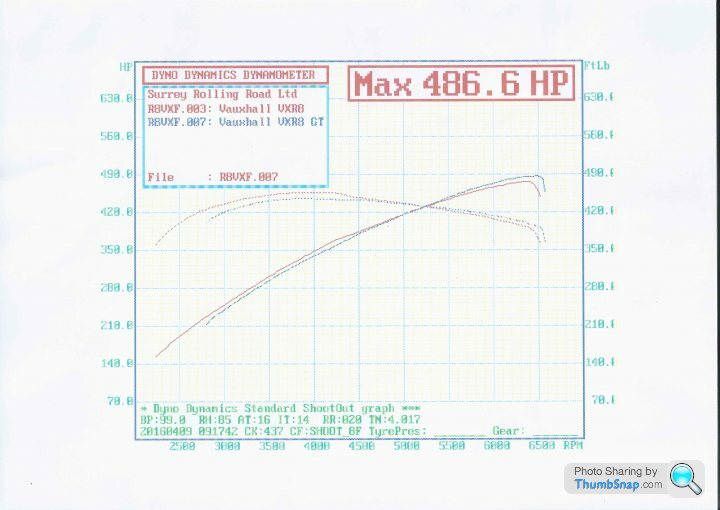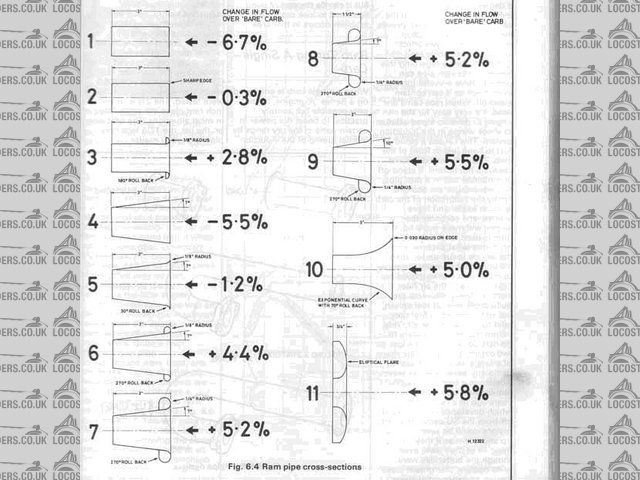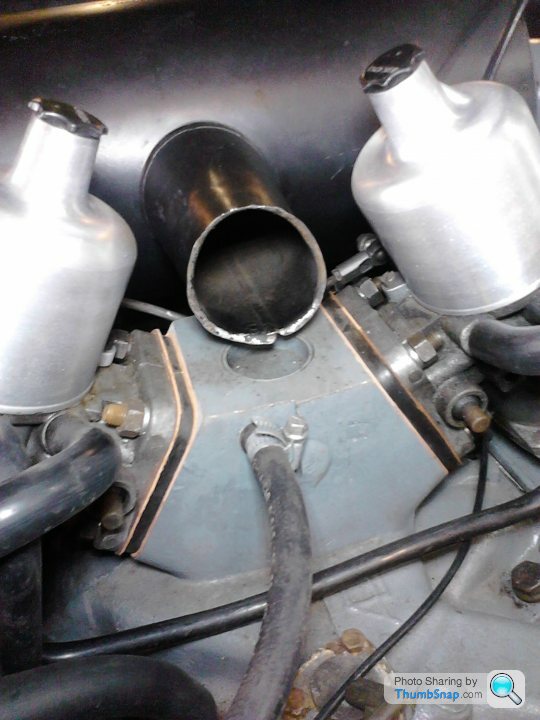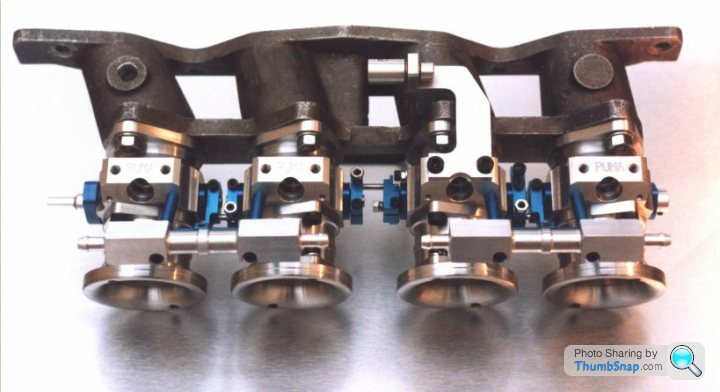Backpressure in exhaust (how to add and remove)
Discussion
jmanning91 said:
^^ yes with intakes the same theory applys.
That the free flowing intake doesn't have the velocity down low but up top it can move much more air. Factory intake versus a FAST 102, HP down low will drop but up top will gain an unreal amount.
So how can you get the best of both worlds? Besides getting an intake not to big or not to small... There's still meat on the bones up top and down low that way
This shows the difference between the stock bimodal intake and a free flowing CAI. You can see where the intake opens on the red line at 4200 RPM. That the free flowing intake doesn't have the velocity down low but up top it can move much more air. Factory intake versus a FAST 102, HP down low will drop but up top will gain an unreal amount.
So how can you get the best of both worlds? Besides getting an intake not to big or not to small... There's still meat on the bones up top and down low that way

AW111 said:
That is how I see it.
There appears to be a best gas speed for exhaust scavenging (determined by experience / experiments). As the volume of exhaust gas goes up at higher rpm, you need a larger diameter pipe to get the same gas speed.
Tuned wave scavenging has a different issue with changing rpm : the reflected waves arrive back at the exhaust valve a (roughly) fixed time after the valve opens/closes, so one exhaust can't be optimal for all rpm.
the mass in the cylinder to expel during exhaust process follows the torque curve for the most part, so as rpm increases the time available to allow the cylinder pressure to be lowered close to ambient reduces.There appears to be a best gas speed for exhaust scavenging (determined by experience / experiments). As the volume of exhaust gas goes up at higher rpm, you need a larger diameter pipe to get the same gas speed.
Tuned wave scavenging has a different issue with changing rpm : the reflected waves arrive back at the exhaust valve a (roughly) fixed time after the valve opens/closes, so one exhaust can't be optimal for all rpm.
too small exhaust size causes higher frictional losses due to excessive gas speed, higher piston pumping losses and excessive cylinder pressure at IVO ( residual cylinder mass blows up the inlet port causing reversion) this seems to be the big driver for why you need more exhaust pipe area (or if the piping is not the restriction more exh duration/lobe area/lift).
Edited by Inline__engine on Wednesday 1st February 11:15
Edited by Inline__engine on Wednesday 1st February 11:30
Tango13 said:
Yamaha did it about 30 years ago with their 'EXUP' systems although they were geared more towards noise reduction than power.
EXUP (and the other bike manufacturers equivalent systems) is nothing to do with adjusting back pressure. It switches the exhaust manifold from a 4-2-1 configuration to a 4-1, giving the low speed torque benefits of a 4-2-1 design and the peak power advantages of a 4-1 design.Power losses seen by reducing back pressure can be caused by changes in fuelling requirements that aren't compensated for. Likewise an exhaust system with too large a bore size may reduce back pressure at the cost of flow velocity and scavenging efficiency. This lead people to believe engines need back pressure to make good power.
I attach a pic of power curves from 2 MGB ex manifolds. The lower power was a standard 3 into 2 (cast iron) then 2 into 1 steel section. This is a siamesed ex port engine so three ex ports for a four cylinder. The 3 into 2 ends in 42 mm ID for the centre port and 41 mm ID for the outer cylinders then into matching twin down pipes and into a single system. The second, higher, power curve is for a 3 into 1 with very narrow pipes at 31 mm ID leading into a collector and then 1 3/4" ex system. The manifold works very well but bottles out early even though it makes more power. As this seemed good we had a much larger bore 3 into 1 made for a race system, bug*er all difference till we hit 5000 rpm when the 3 into 1 was less effective than the race 3 into 2 into 1 manifold  Not lots of experimenting but we kinda thought the power for the road manifolds was dictated by pipe ID rather than layout. Of interest when we increased the pipe diameter on our full race FIA 1840 cc MGB from 2" to 2.25" power increased over the whole power band starting with 1 bhp at lower rpms rising to 2 bhp at 6000 rpm, at 143 to 145 RWHP we were surprised the larger bore made any power improvement. Talking with NMS next door, as soon as they record any back pressure ( down stream of turbo) in the ex system they lose power on their turbo stuff.
Not lots of experimenting but we kinda thought the power for the road manifolds was dictated by pipe ID rather than layout. Of interest when we increased the pipe diameter on our full race FIA 1840 cc MGB from 2" to 2.25" power increased over the whole power band starting with 1 bhp at lower rpms rising to 2 bhp at 6000 rpm, at 143 to 145 RWHP we were surprised the larger bore made any power improvement. Talking with NMS next door, as soon as they record any back pressure ( down stream of turbo) in the ex system they lose power on their turbo stuff.
Peter

 Not lots of experimenting but we kinda thought the power for the road manifolds was dictated by pipe ID rather than layout. Of interest when we increased the pipe diameter on our full race FIA 1840 cc MGB from 2" to 2.25" power increased over the whole power band starting with 1 bhp at lower rpms rising to 2 bhp at 6000 rpm, at 143 to 145 RWHP we were surprised the larger bore made any power improvement. Talking with NMS next door, as soon as they record any back pressure ( down stream of turbo) in the ex system they lose power on their turbo stuff.
Not lots of experimenting but we kinda thought the power for the road manifolds was dictated by pipe ID rather than layout. Of interest when we increased the pipe diameter on our full race FIA 1840 cc MGB from 2" to 2.25" power increased over the whole power band starting with 1 bhp at lower rpms rising to 2 bhp at 6000 rpm, at 143 to 145 RWHP we were surprised the larger bore made any power improvement. Talking with NMS next door, as soon as they record any back pressure ( down stream of turbo) in the ex system they lose power on their turbo stuff.Peter

Edited by PeterBurgess on Wednesday 1st February 19:13
I think there is a common misconception about "back pressure" and IMHO it is confused with tuned exhaust lengths which produce the shockwave at different rpm.
There is a whole science around this and I was lucky enough to get one of my engines specifications run though some calculations by a member on another forum which gave me the required diameters and lengths of not just the exhaust manifold but also collector diameter and length to the can, the lengths of the primary's and secondary's or just primary's for a 4 into 1 it also gave lengths for 1st 2nd 3rd and 4th harmonics. The exhaust manifold just needed a little modificatio to fit the 3rd harmonic requirements and the rest of the system I had made to exploit the data. It is a single can straight through absorbsion system and would have no appreciable restrictive pressure.
The last bit of the data shared also described an ideal intake length from carb bell mouth to inlet valve which is easy to do with different length trumpets.
As an aside I did some reaserch on bellmouth shapes with surprising results on just how much they make a difference to flow.

Now the data I had to provide to receive this wealth of information said to me that it's about the whole package not least the cam duration lift and lobe separation.
There is a whole science around this and I was lucky enough to get one of my engines specifications run though some calculations by a member on another forum which gave me the required diameters and lengths of not just the exhaust manifold but also collector diameter and length to the can, the lengths of the primary's and secondary's or just primary's for a 4 into 1 it also gave lengths for 1st 2nd 3rd and 4th harmonics. The exhaust manifold just needed a little modificatio to fit the 3rd harmonic requirements and the rest of the system I had made to exploit the data. It is a single can straight through absorbsion system and would have no appreciable restrictive pressure.
The last bit of the data shared also described an ideal intake length from carb bell mouth to inlet valve which is easy to do with different length trumpets.
As an aside I did some reaserch on bellmouth shapes with surprising results on just how much they make a difference to flow.

Now the data I had to provide to receive this wealth of information said to me that it's about the whole package not least the cam duration lift and lobe separation.
Blair researched bellmouth shape and wrote a piece on it: http://www.profblairandassociates.com/pdfs/RET_Bel...
Interesting what you have posted Paul, is that empirical or theoretical or both?
On the crankshaft pulley weight thread I posted a power graph from a V8 3500 saloon we tuned on the rollers. It had a nearly sharp edge into an expanding tube entrance to the air box, we gave this a rudimentary radius as shown in the pic below. We increased power with no other changes from 123.6 to 128.2 rwhp ( four runs on each one for consistency) this is +3.7 % on shape of inlet.
Peter

On the crankshaft pulley weight thread I posted a power graph from a V8 3500 saloon we tuned on the rollers. It had a nearly sharp edge into an expanding tube entrance to the air box, we gave this a rudimentary radius as shown in the pic below. We increased power with no other changes from 123.6 to 128.2 rwhp ( four runs on each one for consistency) this is +3.7 % on shape of inlet.
Peter

Mr2Mike said:
EXUP (and the other bike manufacturers equivalent systems) is nothing to do with adjusting back pressure. It switches the exhaust manifold from a 4-2-1 configuration to a 4-1, giving the low speed torque benefits of a 4-2-1 design and the peak power advantages of a 4-1 design.
Power losses seen by reducing back pressure can be caused by changes in fuelling requirements that aren't compensated for. Likewise an exhaust system with too large a bore size may reduce back pressure at the cost of flow velocity and scavenging efficiency. This lead people to believe engines need back pressure to make good power.
Nail.on.head.Power losses seen by reducing back pressure can be caused by changes in fuelling requirements that aren't compensated for. Likewise an exhaust system with too large a bore size may reduce back pressure at the cost of flow velocity and scavenging efficiency. This lead people to believe engines need back pressure to make good power.
30 years ago this very year Geoff (sounds like A Christmas Carol!), I hate to think how many hours were spent on the flow bench and grinder to achieve that Championship, I am still using the same head spec from all those years ago as our basis for TR4 race heads. Offsetting the head to improve flow and bhp is making a comeback too!
Peter
Peter
PeterBurgess said:
Interesting what you have posted Paul, is that empirical or theoretical or both?
On the crankshaft pulley weight thread I posted a power graph from a V8 3500 saloon we tuned on the rollers. It had a nearly sharp edge into an expanding tube entrance to the air box, we gave this a rudimentary radius as shown in the pic below. We increased power with no other changes from 123.6 to 128.2 rwhp ( four runs on each one for consistency) this is +3.7 % on shape of inlet.
Peter

Interesting.On the crankshaft pulley weight thread I posted a power graph from a V8 3500 saloon we tuned on the rollers. It had a nearly sharp edge into an expanding tube entrance to the air box, we gave this a rudimentary radius as shown in the pic below. We increased power with no other changes from 123.6 to 128.2 rwhp ( four runs on each one for consistency) this is +3.7 % on shape of inlet.
Peter

And three cheers for actually doing back-to-back testing with a single modification.
I try to do single changes whenever possible, good scientific method, drummed in when I did psychology  The really good point to me is the owner, of a stunning, almost original car, let me have a play. The car( a green and used for undercover work) was a third owner from new 76 model. 1st owner Met Police ( I am told this is the last P6 they bought), second owner was a police mechanic from the Met. We wondered who butchered, and why, the air intake! I asked the owner if I could do a 'Professionals' across the bonnet debunk when I parked it outside the unit but he declined
The really good point to me is the owner, of a stunning, almost original car, let me have a play. The car( a green and used for undercover work) was a third owner from new 76 model. 1st owner Met Police ( I am told this is the last P6 they bought), second owner was a police mechanic from the Met. We wondered who butchered, and why, the air intake! I asked the owner if I could do a 'Professionals' across the bonnet debunk when I parked it outside the unit but he declined 
Peter
 The really good point to me is the owner, of a stunning, almost original car, let me have a play. The car( a green and used for undercover work) was a third owner from new 76 model. 1st owner Met Police ( I am told this is the last P6 they bought), second owner was a police mechanic from the Met. We wondered who butchered, and why, the air intake! I asked the owner if I could do a 'Professionals' across the bonnet debunk when I parked it outside the unit but he declined
The really good point to me is the owner, of a stunning, almost original car, let me have a play. The car( a green and used for undercover work) was a third owner from new 76 model. 1st owner Met Police ( I am told this is the last P6 they bought), second owner was a police mechanic from the Met. We wondered who butchered, and why, the air intake! I asked the owner if I could do a 'Professionals' across the bonnet debunk when I parked it outside the unit but he declined 
Peter
Evoluzione said:
Blair researched bellmouth shape and wrote a piece on it: http://www.profblairandassociates.com/pdfs/RET_Bel...
"The best bellmouths are short and fat with the elliptical profile the winner"Another interesting article
For me being a humble hobbiest it's about trying to make a little difference if I can.
What this article highlights for me is that my previous thoughts of using longer intake trumpets to achieve the required intake length is probably the wrong way and I should consider a longer fabricated inlet manifold instead.
Edited by PaulKemp on Sunday 5th February 08:54
PeterBurgess said:
30 years ago this very year Geoff (sounds like A Christmas Carol!), I hate to think how many hours were spent on the flow bench and grinder to achieve that Championship, I am still using the same head spec from all those years ago as our basis for TR4 race heads. Offsetting the head to improve flow and bhp is making a comeback too!
Peter
Your first offset head Peter?Peter

I have a set of these, bike throttle bodies to play with which will replace a set off bike carbs with less than ideal bell mouth shapes.
It won't be possible for me to evaluate the two as I don't have a flow bench and I'm swapping carbs for injection.
http://i750.photobucket.com/albums/xx141/snapperpa...
It won't be possible for me to evaluate the two as I don't have a flow bench and I'm swapping carbs for injection.
http://i750.photobucket.com/albums/xx141/snapperpa...
PaulKemp said:
"The best bellmouths are short and fat with the elliptical profile the winner"
Another interesting article
For me being a humble hobbiest it's about trying to make a little difference if I can.
What this article highlights for me is that my previous thoughts of using longer intake trumpets to achieve the required intake length is probably the wrong way and I should consider a longer fabricated inlet manifold instead.
I interpret the quoted statement as the transition from bellmouth to straight profile should be short and not have a tapered funnel.Another interesting article
For me being a humble hobbiest it's about trying to make a little difference if I can.
What this article highlights for me is that my previous thoughts of using longer intake trumpets to achieve the required intake length is probably the wrong way and I should consider a longer fabricated inlet manifold instead.
Edited by PaulKemp on Sunday 5th February 08:54

The length of the intake behind the bellmouth should not effect the flow, so where in the intake you place your length should also not matter, before or after the butterfly.
Something to think about when using tuned lengths is that where in the rpm range there is an advantage to be had, there will be another point where you will lose power. This applies to intake and exhaust, with the added complication that the speed of sound in a gas changes with temperature, so the exhaust can give some headaches when tuning.
You never want back pressure on a 4 stroke.. It is a complete misconception. Try dynoing or driving an car with a partially blocked exhaust..
What it is is gas speed.. A smaller diameter exhaust will have a higher gas speed at lower rpm, boosting the low end by increasing scavenging at that point. However, at the top end it might then be restrictive due to the fact it can't flow enough volume. This is where back pressure comes from. You don't want it, but it is a side effect of a smaller flowing exhaust which helps the bottom end.
The perfect exhaust would have high gas speeds, and no back pressure, however with many things engine flow related it is a compromise..
What it is is gas speed.. A smaller diameter exhaust will have a higher gas speed at lower rpm, boosting the low end by increasing scavenging at that point. However, at the top end it might then be restrictive due to the fact it can't flow enough volume. This is where back pressure comes from. You don't want it, but it is a side effect of a smaller flowing exhaust which helps the bottom end.
The perfect exhaust would have high gas speeds, and no back pressure, however with many things engine flow related it is a compromise..
Gassing Station | Engines & Drivetrain | Top of Page | What's New | My Stuff




